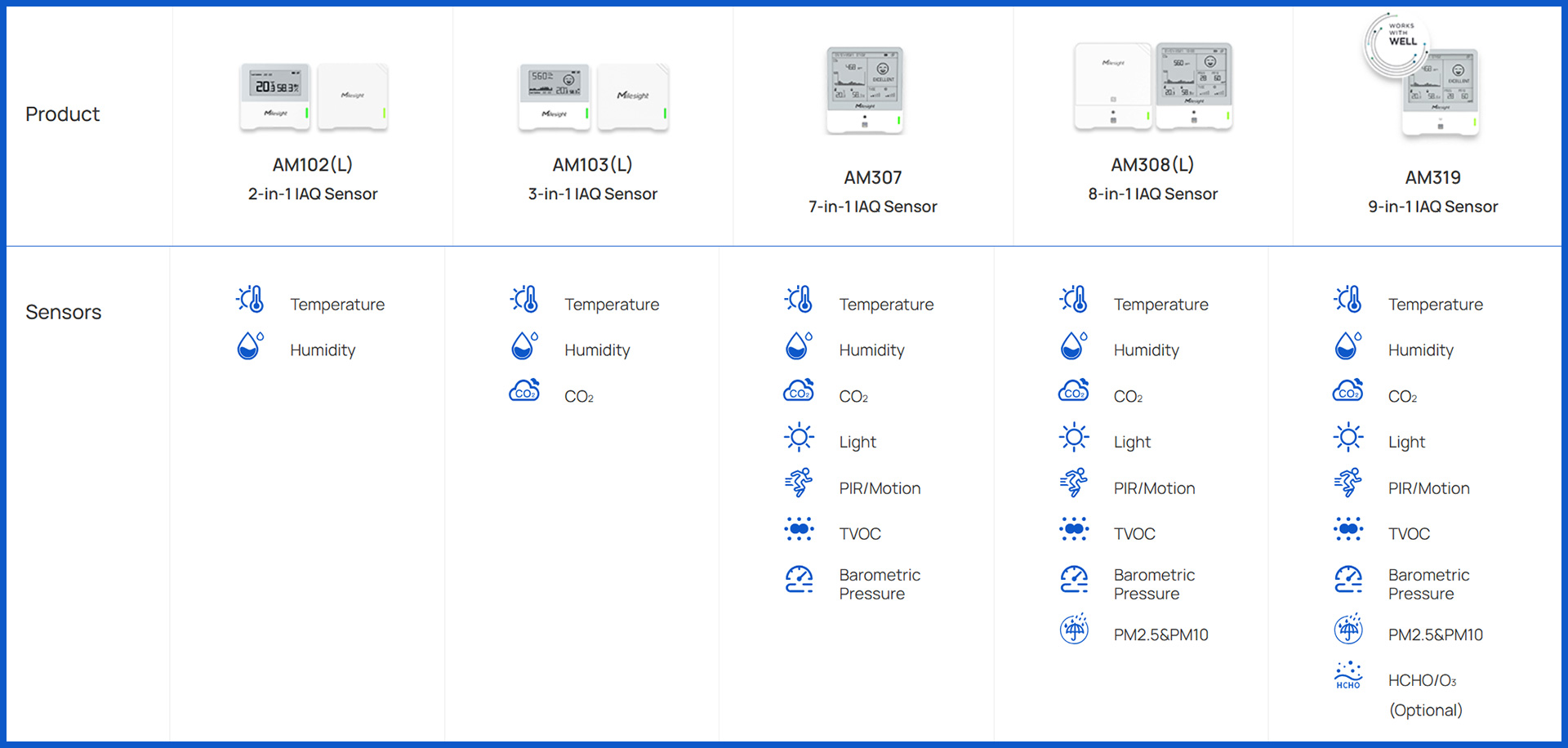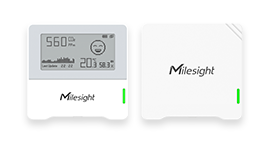The Ultimate Guide to Improving
Indoor Air Quality (IAQ)
with Smart HVAC Controls


In environments where performance and well-being are most critical, such as offices, schools, and hospitals, we spend up to 90% of our time indoors. Yet, an invisible threat often goes unaddressed within these spaces. According to the U.S. Environmental Protection Agency (EPA), indoor concentrations of some pollutants are frequently 2 to 5 times higher than typical outdoor levels. This challenge is amplified in modern, energy-efficient buildings, where airtight envelopes designed to reduce energy consumption can inadvertently trap pollutants like volatile organic compounds (VOCs), fine particulate matter (PM2.5), and carbon dioxide (CO2).
For building operators and facility managers, poor IAQ is a critical operational liability that impacts everything from employee productivity to student concentration and patient health. Effectively addressing this challenge requires a fundamental shift away from outdated, temperature-focused regulation. A modern Building Management System (BMS) must leverage real-time IAQ data to intelligently command HVAC operations, creating a truly healthy, safe, and productive indoor environment.
Why Your Building Management System Needs to Prioritize IAQ & HVAC Integration
Integrating indoor air quality (IAQ) monitoring with your HVAC system is no longer optional. It's essential for creating healthier, more efficient, and more responsive buildings.
From Siloed Control to Integrated Intelligence
Traditionally, HVAC systems focused on a single variable: temperature. This narrow approach often resulted in inefficiencies and ignored the complex factors that influence indoor air quality across different types of buildings.
With the rise of IoT and smart building automation, IAQ and HVAC integration has entered a new era. Advanced IoT sensors now capture detailed air quality data, such as CO₂, PM2.5, and TVOCs, and transmit it through gateways to the central Building Management System (BMS). The BMS then analyzes this real-time information and coordinates HVAC operations accordingly, issuing precise adjustments that go beyond simple temperature control. This shift transforms building operations from reactive responses into proactive, automated, and intelligent IAQ and environmental management.
The Benefits of Integrated IAQ and HVAC Systems
When IAQ and HVAC work together, the benefits are clear. Integration improves more than just comfort—it enhances occupant productivity, supports health and well-being, and reduces energy consumption by eliminating unnecessary ventilation. The result: better indoor environments, happier occupants, and measurable savings for your operational budget.
Milesight IAQ Control Products: The Foundation for Healthier Buildings
AM Series IAQ Sensors: Precision IAQ Monitoring
The AM Series serves as the eyes and ears of your building. These devices are engineered to accurately monitor a wide range of key air quality parameters, including PM2.5, CO₂, TVOCs, temperature, and humidity. By delivering precise, real-time data, they form the foundation of any intelligent IAQ and HVAC solution.
Beyond basic measurements, the AM series also includes light and PIR sensors, enabling automated lighting adjustments and occupancy detection. This allows dynamic coordination of HVAC and lighting systems, ensuring occupant comfort while reducing unnecessary energy consumption. Certain AM models feature built-in display screens, allowing users to view indoor air quality status instantly.

WT Series Smart Thermostats: Intelligent Precision HVAC Control
The WT Series Smart Thermostat directly regulates HVAC systems, providing precise zone-based control of heating and cooling and making it adaptable to a wide range of environments, from residential to commercial buildings. Designed for diverse global markets, the series's rich product lineup supports applications from radiator heating systems in Europe to RTUs in North America, delivering tailored comfort and energy efficiency. When integrated with IAQ and occupancy data, the WT Series further optimizes indoor environments, ensuring healthier conditions and enhanced energy performance worldwide.
IoT Controllers: UC Series
The UC Controllers collect data from wired sensors via RS485/RS232 interfaces and convert it into LoRaWAN® data packets. This ensures that traditional wired devices can seamlessly integrate into a smart IAQ and building management ecosystem.
LoRaWAN® Gateways
Milesight LoRaWAN® Gateways receive data from UC controllers and IAQ sensors, transmitting it directly to the Building Automation System (BAS). Supporting protocols such as BACnet, Modbus, and MQTT, these gateways ensure smooth integration with existing BAS infrastructure, enabling centralized monitoring and intelligent automation rules.
From Data to Action: Intelligent IAQ & HVAC Solution Explained
In modern smart buildings, integrating IAQ monitoring with HVAC systems is key to ensuring comfort, health, and energy efficiency. This process can be understood in three essential steps:

Step 1: Real-Time Monitoring — Continuous IAQ Data Collection
High-precision IAQ sensors continuously measure critical air quality parameters such as CO₂, PM2.5, TVOCs, temperature, and humidity. These sensors provide real-time insights, enabling the building management system (BMS) to understand the indoor environment at all times and respond to changing conditions effectively.
Step 2: Data Transmission — Connecting Sensors to the BMS
Sensor readings are collected through controllers and transmitted via gateways to the BMS. The gateways handle protocol translation and ensure secure, reliable communication between diverse building devices and the central system. This approach allows both wired and wireless sensors to feed data into the BMS, creating a unified indoor environmental management approach.
Step 3: Automation & HVAC Response — Intelligent Adjustments with Thermostat Control
Once real-time IAQ data reaches the BMS, smart thermostats directly regulate HVAC operations, adjusting airflow, ventilation, and heating or cooling cycles based on current indoor air quality and comfort requirements. This automated control ensures optimal IAQ, energy efficiency, and occupant comfort, while also allowing integration with lighting or other building systems to reduce energy waste further.
Leveraging LoRa Technology for Seamless Connectivity
Traditional connectivity methods like wired cabling often face challenges in large or complex buildings. High installation costs, limited coverage, and difficulties in integrating with older infrastructure can slow down modernization. LoRa technology overcomes these barriers, offering a flexible and future-ready approach to IAQ and HVAC integration. From retrofitting legacy buildings to upgrading traditional Building Management Systems (BMS), LoRa makes connectivity simpler, more scalable, and cost-effective.
Wireless, Scalable, and Easy to Deploy
LoRa operates wirelessly, eliminating the need for extensive cabling that can be costly and disruptive, especially in existing buildings. This makes it ideal for retrofit projects where installing new wiring is impractical. Its scalability allows facility managers to start small and expand coverage across more floors or zones without major infrastructure changes, supporting both new developments and upgrades to traditional BMS environments.
Reliable Long-Range Data Transmission
Unlike short-range wireless solutions, LoRa offers long-distance communication that can penetrate walls and other obstacles commonly found in large facilities. This ensures that IAQ sensors, controllers, and gateways can maintain reliable connections even in challenging building layouts.
To further strengthen connectivity, Milesight D2D technology enhances this further by enabling direct device-to-device communication, delivering faster response times for real-time HVAC adjustments. Together, LoRa and D2D ensure stable, low-latency data exchange for smarter, more responsive indoor air quality management.
Low Power Consumption for Cost-Effective Operation
One of LoRa's most significant advantages is its low energy demand. Devices such as IAQ sensors can run for years on a single battery, dramatically reducing maintenance requirements. This energy efficiency translates directly into lower operational costs, making it easier to manage large networks of devices while maintaining cost-effectiveness in both retrofits and new smart building deployments.
Key Benefits of IAQ HVAC Integration for Healthier, Smarter Buildings
Integrating IAQ monitoring with HVAC systems goes beyond technology—it creates measurable benefits for buildings, occupants, and operators. Here’s how a truly healthy building is achieved:
Health & Wellbeing
A healthier indoor environment starts with cleaner air. By continuously monitoring and controlling CO₂, PM2.5, TVOCs, and humidity, our integrated solution reduces airborne pollutants and allergens, enhancing occupant comfort in buildings. This helps commercial offices, schools, and residential buildings maintain safer, more comfortable spaces, supporting occupant wellness and reducing health-related absenteeism.
Energy Efficiency & Cost Savings
Intelligent IAQ and HVAC integration prevents unnecessary system operation, optimizing airflow and temperature only where and when it is needed. This reduces energy consumption and utility bills. Predictive maintenance and zone-based alerts further cut labor costs by allowing facility managers to act proactively, rather than reactively, enhancing operational efficiency.
Enhanced Productivity & Performance
Good indoor air quality directly influences cognitive performance, focus, and overall productivity. Studies have shown that improved IAQ can boost employee attention and task performance in office environments. By maintaining optimal air quality levels, our solution supports a more productive, high-performing workspace, making the building healthier for everyone inside.
Sustainability & Building Certifications
Integrating IAQ and HVAC solutions aligns with green building trends and supports certifications such as WELL and LEED. Optimized energy use, reduced carbon footprint, and improved indoor environments not only contribute to environmental sustainability but also enhance property value and reputation, reinforcing the building’s image as a forward-thinking, healthy space.
Success Stories
StorHub Self-Storage, Asia Pacific – LEED-Certified Facilities: Milesight AM319 sensors and LoRaWAN® gateways were deployed across StorHub facilities to monitor indoor air quality and utility consumption. The wireless IoT solution enabled real-time data collection for LEED certification, streamlined facility management, and supported environmental sustainability without disrupting daily operations.
Abu Dhabi University, UAE – Smart Campus Deployment: Milesight IAQ sensors and LoRaWAN® gateways were deployed to monitor CO₂, temperature, humidity, and occupancy across campus buildings. These smart devices enable real-time HVAC control, improved indoor air quality, and adaptive energy management, enhancing student comfort, reducing energy costs, and supporting sustainability goals.
Valencia, Spain – Wellbased Project: 130 Milesight AM103L sensors were deployed in vulnerable households to monitor CO₂, temperature, humidity, and energy usage. The data helps improve indoor comfort, link energy use with health and wellbeing, and support community education. Valencia, European Green Capital 2024, leverages this project to advance sustainability goals and demonstrate practical IAQ and energy monitoring solutions in real-world urban settings.
TAV Airports, Turkey – IoT-Based Air Quality Monitoring: Milesight AM308L IAQ sensors and LoRaWAN® gateways were deployed to monitor air quality in crowded airport areas. These smart devices provide real-time data for centralized management and AI-driven insights, improving passenger comfort, operational efficiency, and energy management while supporting healthier airport environments.
Milesight Related Products

WT101 Smart Radiator Thermostat
Time for Energy Saving via Heating Control in the IoT Wave
Explore More
WT303/WT304 Smart Fan Coil Thermostat
Smart Scheduling & Precise Climate Control, Redefines FCU Efficiency
Explore More






